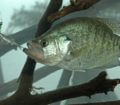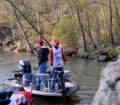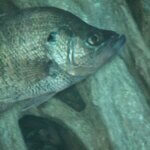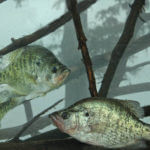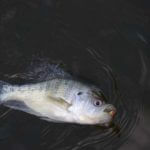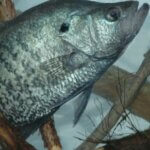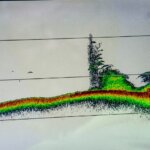 Editor’s Note: Are you tired of going fishing and not catching any crappie? Would you like to eliminate some of the guesswork from finding and taking crappie? Would you like to know the secret haunts and specialized techniques that will help you take speckled sides on every outing? Crappie-fishing guides and tournament crappie pros must find and take papermouths every day they’re on the water. They’ve unlocked many of the mysteries crappie have held beneath the surface for years, and this week we’re covering some of their most-productive tactics.
Editor’s Note: Are you tired of going fishing and not catching any crappie? Would you like to eliminate some of the guesswork from finding and taking crappie? Would you like to know the secret haunts and specialized techniques that will help you take speckled sides on every outing? Crappie-fishing guides and tournament crappie pros must find and take papermouths every day they’re on the water. They’ve unlocked many of the mysteries crappie have held beneath the surface for years, and this week we’re covering some of their most-productive tactics.
Many of these anglers define one of the keys to catching more crappie is determining how far the fish are off the bottom. When most anglers look at their depth finders and see crappie, they want to know how far the crappie are from the surface. However, I’ve learned that generally no matter at what depth the crappie are from the surface, you consistently can find them at the same depth on the same day when you know the distance they are from the bottom.
 Many guides put out stake beds and brush piles at varying depths for crappie on various lakes around the U.S., particularly on Kentucky Lake and Alabama’s Lake Eufaula. As one guide reports, “Once I learn at what depth the crappie are holding, then I can pinpoint which stake beds to fish. For instance, if I have a stake bed in 10 feet of water, and I spot crappie 2 feet off the bottom on my depth finder near that stake bed 2 feet off the bottom, then I know generally I can expect to locate crappie 2-feet off the bottom on all my 10-foot-deep stake beds. I’ve found that approximately 80 percent of crappie usually hold at the same level, since crappie will stratify at one water depth.”
Many guides put out stake beds and brush piles at varying depths for crappie on various lakes around the U.S., particularly on Kentucky Lake and Alabama’s Lake Eufaula. As one guide reports, “Once I learn at what depth the crappie are holding, then I can pinpoint which stake beds to fish. For instance, if I have a stake bed in 10 feet of water, and I spot crappie 2 feet off the bottom on my depth finder near that stake bed 2 feet off the bottom, then I know generally I can expect to locate crappie 2-feet off the bottom on all my 10-foot-deep stake beds. I’ve found that approximately 80 percent of crappie usually hold at the same level, since crappie will stratify at one water depth.”
This guide says that if he goes to a brush top in 20 feet of water, then he reasonably can expect the crappie to be holding 2-feet off the bottom there in 18 feet of water. When he checks a brushtop in 8 feet of water, then the crappie may be at 6 feet — 2 feet off the bottom again. But he also mentions that he usually won’t change his fishing as drastically as from 18 feet to 6 feet. “Knowing the distance the crappie are from the bottom and determining at what depth the crappie are concentrating in is an example of a pattern within a pattern. By pinpointing what these patterns are, you can catch more fish. After I learn crappie are holding around brush at a certain depth from the bottom, then I need to find out how the crappie are positioned in relationship to that cover. If crappie are holding above the brush in one spot, generally they’ll be holding above the brush on various brush piles. If the fish are holding off to one side of the brush at one location, then you consistently can pinpoint them off to the side of the brush at other sites.”
 However, don’t forget that the position of the crappie on the cover will change at different times of the day. In the summertime, early in the morning and late in the evening, crappie will be close to the surface, because they generally are more shallow in the water during the nighttime than in the daytime. Generally crappie will remain in the position where you locate them for about 4 hours. Some days they may stay at the same depth of water at the same distance from the bottom and in the same location from the cover all day long. If the day is overcast, the crappie generally will hold their position in the water more consistently all day.
However, don’t forget that the position of the crappie on the cover will change at different times of the day. In the summertime, early in the morning and late in the evening, crappie will be close to the surface, because they generally are more shallow in the water during the nighttime than in the daytime. Generally crappie will remain in the position where you locate them for about 4 hours. Some days they may stay at the same depth of water at the same distance from the bottom and in the same location from the cover all day long. If the day is overcast, the crappie generally will hold their position in the water more consistently all day.
 To learn more about fishing for crappie, check out John E. Phillips’ book, “Crappie – How to Catch Them Spring and Summer,” available in Kindle, print and Audible versions at http://amzn.to/WGaJLT.
To learn more about fishing for crappie, check out John E. Phillips’ book, “Crappie – How to Catch Them Spring and Summer,” available in Kindle, print and Audible versions at http://amzn.to/WGaJLT.

